Antique Watson Brass Research Microscope (Variation of Edinburgh H) c1921, Cased
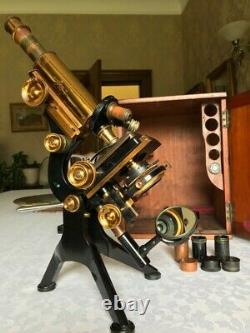
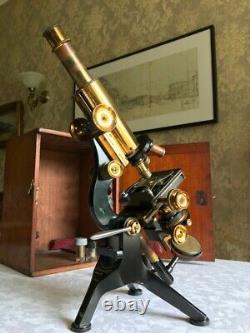
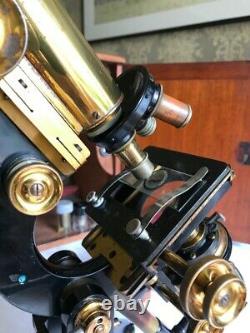


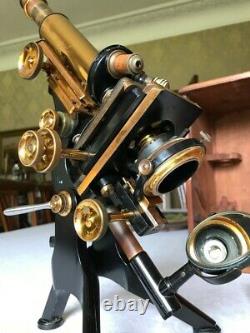
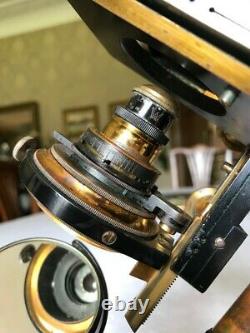
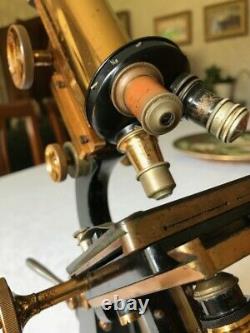

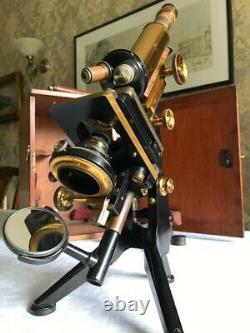



This listing is for a rather fine example of an antique Research model of monocular microscope in lacquered brass by W. Watson & Sons Limited of London.
It dates from around 1921 based on the sequential Watson production number of 26702, which is engraved onto the frame, just above the rear tripod foot. It's what Watson christened as their "Research" model and to look at it it's immediately clear that the design is a hybrid, being a tripod base that's very similar (in fact it's identical) to the tripod base Watson used on their long-running Edinburgh models (in production from 1887 to about 1945) and the upper limb design that's more reminiscent of a Service/Bactil model, but in a lacquered brass finish rather than a black livery. It makes a rather fine and very usable instrument and one wonders why Watson only made this Research design in relatively limited numbers. Certainly having the coarse and fine focus thumb-wheels positioned on both sides of the upper limb as found in the Service/Bactil models is perhaps more user-friendly and a more modern configuration. Maybe we'll never know Watson's reasoning for not producing the Research model in significant numbers and since all microscope production at Watson finally ceased in 1970, there's no-one available to ask! In the listing photos there's an extract from a 1920s Watson catalogue that gives a brief description of the Research model along with a price list - which also demonstrates what amazingly good value vintage microscopes are these days. This Research model is essentially an excellent piece of British optical engineering and really does show its quality from every one of its many intricate parts, based on good materials, great design and skilled workmanship with plenty of hand-finishing carried out in this period in order to produce an instrument of this quality.Have a detailed look at the construction, even the brass screws and other furniture really do scream top quality from every component. This is therefore a sturdy, quality, well-made antique microscope in really good original condition, fully working and a nice variation on the well-known Edinburgh H model. All moving parts seem to be mainly free from much in the way of wear - I've given everything a light lubrication and sensitive clean in order not to disturb any of the original lacquer finishes.
Turning to the technical details, the coarse focus is via rack and pinion, with fine focus achieved via separate twin thumb-wheels which operate an internal vertical lever/cam system and work nice and smoothly. The fine focus system also has a graduation scale on the right hand side. With the optics, this Watson microscope comes fitted with a period graduated brass eyepiece draw-tube and tthree quality vintage eyepieces that with good illumination produce excellent images: - 6x magnification - No. 2 - 8x magnification - No.
3 - 10x magnification - No. (All the objectives have storage canisters with three being period Watson canisters). Overall, the range of magnification available with this example therefore ranges from about 7.5x when using the ultra low-power para objective up to a perfectly respectable 1,000x when using oil immersion and bright illumination. The microscope's fully mechanical stage is an original Watson item in brass and is very similar to the mechanical stages that Watson used on the Edinburgh range of microscopes.It's currently fitted with two later specimen clips and is adequate for holding slides during inclined viewing. The freely running x/y controls are concentric on this model, which is a novel Watson design, with most versions of this mechanical stage usually fitted with separate x and y-axis thumb-wheels. The concentric controls operate well, offering good control of specimen positioning, which is a real advantage for higher magnification work. On the sub-stage, we have what looks like quite a specialist Watson condenser - it's marked as "para condenser 2/7th inch less front lens 4/10th inch 0.35 NA" and it's on a height adjustable rack and pinion mount which also swings out to allow changing condenser type, carrying out maintenance or for microscopy techniques that don't require using a condenser.
The condenser assembly also has a working iris with lever adjustment and 0.1 to 1.0 graduation marks and centering via two brass thumb-screws. There's a swing-out holder for fitting coloured, opaque or dark-field filters - I've put the vernier calipers on this because it looks a lot smaller than filter carriers you normally find on vintage/antique Watsons and it measures 24mm diameter - so is quite a small size.
Lighting is via a plano-concave mirror held in a brass carrier with gimbal which is in very good condition on a slider mechanism that sits on an adjustable brass support arm. The period silvering is also in good condition on both sides of the mirror. All the instrument's controls operate fairly smoothly including coarse focus, fine-focus, eyepiece draw-tube, mechanical stage, condenser and plano-concave mirror.
The instrument has been in recent use and has also been given a light service and clean. This is a great visual and working example of Watson's Research model, highly original with a comprehensive specification, good optics and it's essentially in collectable condition with lovely gleaming brass-work that's showing some age-related spotting and tarnishing which is very much in keeping with its age and usage and really gives it some additional character. The brass-work catches the sun perfectly, glowing with a lovely yellow/golden colour and I hope that the listing photos do it justice because it presents really well close up in the metal. This is the only Watson Research model I've ever had the pleasure of owning, so I anticipate that it may be quite some time before I will add another one of these to my collection.
There's also a period Watson wooden storage case with this example, which is also in excellent condition for its age with nice brass/wooden handle, internal lens rack and it's just missing a lock & key, but is fitted with a small cupboard latch to keep the door closed. Thanks for looking - please also check out my other listings if you get a chance. The item "Antique Watson Brass Research Microscope (Variation of Edinburgh H) c1921, Cased" is in sale since Saturday, July 10, 2021. This item is in the category "Antiques\Science/Medicine\Scientific Instruments". The seller is "arcboutant" and is located in Glasgow.
This item can be shipped worldwide.
- Period: 1901 to 1950
- Material: Brass
- Type: Microscope
- Antique: Yes

